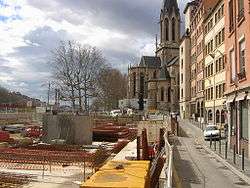Place Benoît-Crépu
The Place Benoît-Crépu is a stone-paved square, located in Saint-Georges quarter, on the banks of the Saône (Vieux Lyon), in the 5th arrondissement of Lyon. It has fountains with dolphin heads, many benches and trees and a playground. The place belongs to the area classified as World Heritage Site by UNESCO.

History
In the thirteenth century the Order of St. Anthony was established here.[1] This square partly absorbed the Rue Pierre-Percée, now called rue Monseigneur Lavarenne.[1]
The square was modified when the Quai Fulchiron was created in 1858, then expanded after the destruction of houses that prolonged the rue Lavarenne.[2] The square was renovated for the construction of an underground car park from 2001 to 2006. During this work, various objects, including three Gallo-Roman boats, relatively well preserved, dating from the first or second century, were discovered. Similarly, while digging the tunnel which connects the parking under the rue Monseigneur-Lavarenne, several buildings of the Middle Ages were discovered, apparently abandoned after the many floods of the Saône. Some of the old ramparts were also found. All archaeological discoveries caused a six to nine-month delay of work.[3][4]
This square is situated on one of the many ports of the Saône, the port du Sablet or Sablé,[5] which existed from the late Middle Ages to 1844, and was destroyed with the surrounding houses to develop the current wharf (e.g. a house was demolished in 1707 to create the square).[6] The square was formerly named Place du Port-Sablé (also spelled Sablet, which perhaps referred to the sandy nature of the soil or the unloading of vessels which contained sand).[7] In 1866, the church of Saint-Pierre-le-Vieux, which was on the square, was demolished.[8] The current name was assigned by the municipal council of 23 November 1894 as tribute to Benoît Crépu, a tanner born in Lyon on 23 January 1839 and died in the city on 4 April 1893, as he had donated part of his fortune to the city of Lyon.[9] In his will,[10] he gave his building located at No. 24 rue de la Quarantine to be sold for the benefit of secular schools.[11]
Architecture and description
The square has limestone benches and beautiful pavements. The vegetation consists mainly of silk trees and groves of laurel.[12]
The majority of the square consists of two rows of four to six-storey buildings with narrow facades generally built in the 19th century. The building between the wharf and the rue Lavarenne was created in 1845 ; it has six different floors with a Virgin and Child at the corner of the wharf. At No. 8, two plaques say the height of the floods of the Saône on 5 November 1840 and 21 May 1856.[2]
After having served for a while as a station for trolleys and buses, the square was gradually transformed into a large garden through a space reorganization.[7] In 2008, landscapers of the Ilex agency completely modified the square.[12]
The Église Saint-Georges is near the square.
See also
References
- Brun De La Valette, Robert (1969). Lyon et ses rues (in French). Paris: Le Fleuve. p. 40.
- "Place Benoît-Crépu" (in French). Rues de Lyon. Retrieved 8 January 2010.
- "Place Benoît-Crépu" (in French). Institut national de recherches archéologiques préventives. 5 October 2009. Retrieved 8 January 2010.
- Françoise, Dumasy; François, Queyrel (2009). Archéologie et environnement dans la Méditerranée antique (in French). p. 247.
- Pelletier, Jean (1985). Lyon pas à pas — son histoire à travers ses rues — Rive droite de la Saône, Croix-Rousse, quais et ponts de la Saône (in French). Roanne / Le Coteau: Horvath. p. 30. ISBN 2-7171-0377-5.
- Vanario, Maurice (2002). Rues de Lyon à travers les siècles (in French). Lyon: ELAH. p. 235. ISBN 2-84147-126-8.
- Pelletier, Jean; Delfante, Charles (2009). Places de Lyon — Portraits d'une ville (in French). Lyon: Stéphane Bachès. pp. 110–11. ISBN 978-2-915266-64-1.
- Dureau, Jeanne-Marie (1994). Lyon, les années Rabelais (1532-1548) (in French). p. 137.
- Vanario, Maurice (2002). Rues de Lyon à travers les siècles (in French). Lyon: ELAH. p. 91. ISBN 2-84147-126-8.
- Maynard, Louis (2009). Histoires, légendes et anecdotes à propos des rues de Lyon, avec indication de ce qu'on peut y remarquer en les parcourant (in French). Les Traboules. pp. 51, 52. ISBN 978-2-911491-57-3.
- Vachet, Adolphe (1902). À travers les rues de Lyon (in French) (1982, Marseille ed.). Lyon: Laffitte reprints. p. 74. ISBN 2-7348-0062-4.
- Eberhard, Pierrick (2010). Lyon et ses parcs et jardins — Grand Lyon, département du Rhône (in French). Lyon: Éditions Lyonnaises d'Art et d'Histoire. p. 41. ISBN 2-84147-218-3.
| Wikimedia Commons has media related to Place Benoît Crépu (Lyon). |